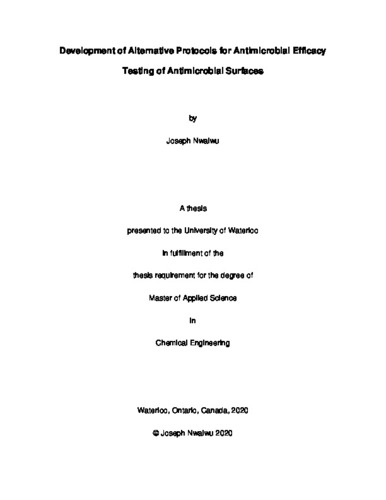| dc.description.abstract | Self-disinfecting surfaces have been studied for a long time for use in reducing the occurrence of infections. Several industries are focused on manufacturing antimicrobial products with high toxicity to microbes for contact killing. However, when these products are manufactured, they need to be tested to determine their antimicrobial efficacy before they can be sold for public use. This study focuses on developing fast and accurate protocols to determine the antimicrobial efficacy of antimicrobial products and can be useful for irregular or larger surfaces where some regulatory protocols based on small coupons cannot be applied.
Three different protocols were developed and their results for testing antimicrobial products using industrially manufactured samples against E. coli and P. aeruginosa were compared to results obtained from a coupon-based method which is similar to the EPA protocol. Protocol 1 (modified EPA protocol) was used as the control, for comparison with other protocols and this protocol involved applying bacteria solution on a test surface coupon for 1-hour contact time, the test surface was then placed in a beaker containing phosphate buffered saline (20 µl), sonicated for 5 minutes, then bacteria solution was plated on agar plates and incubated. Protocol 2 involved applying bacteria solution on a test surface for 1 hour, then the bacteria solution was retrieved using a pipette, dilutions were made, plated and incubated. Protocol 3 involved applying bacteria onto the test surface, then the test surface was inverted onto an agar plate surface, left for 1-hour contact time, then surface was removed, and plate incubated. Protocol 4 involved applying bacteria onto test surface and left in contact for 1 hour, then stamped onto an agar surface for 30 seconds, removed and incubated. The results from comparing the log reductions and killing percentages from these protocols show that protocol 4 show the best comparison for both microorganisms, compared to results from protocol 1 and possesses less coefficient of variation calculations in all cases. Protocol 2 shows good comparison with results from the Protocol 1 however, there is higher coefficient of variation while protocol 3 did not correlate with results from the Protocol 1 when bacteria is applied on a pure copper surface.
Plate counting techniques are the widely used for enumeration of live bacteria. It involves plating microorganisms on an agar plate, incubation for 24 – 48 hours then counting of colonies formed. Obtaining results using this technique takes time and can be inaccurate sometimes depending on the concentration of plated microorganism. An accurate flow cytometry FCM technique was developed to determine the antimicrobial efficacy of test samples. Microbial solution (E. coli, P. aeruginosa and Saccharomyces cerevisiae) stained with calcein am dye was analysed with a flow cytometer. FCM results showed correlation with plate count results when the microbial solution was diluted to 104 CFU/ml without application on a copper surface but failed to correlate with plate count results when bacterial solution was exposed to copper, due to the interaction between calcein AM and copper. So, another technique involving staining 106 CFU/ml yeast solution with propidium iodide after exposure to copper surface and comparing with plate count results was studied. This technique was used to accurately predict the log reduction of yeast applied on some industrially manufactured antimicrobial samples with a maximum underestimation and overestimation range of -0.33 and 0.48. | en |

